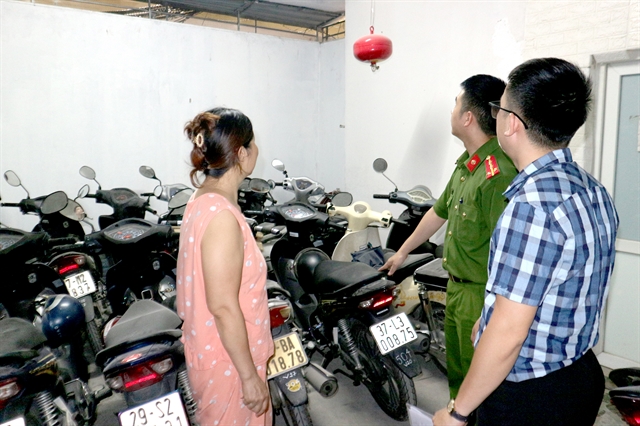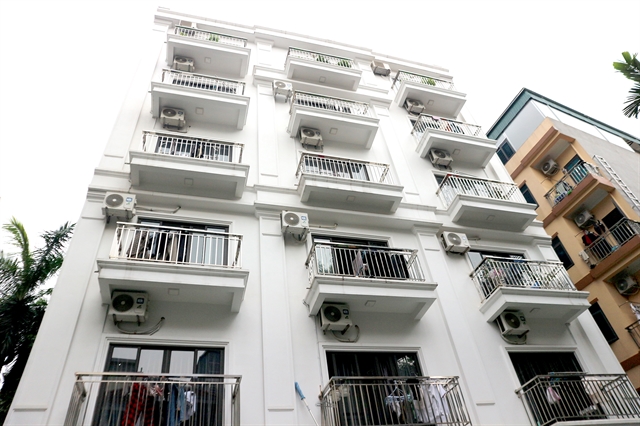 |
| Authorities check the parking area at a rental facility in Hà Nội.— VNA/VNS Photo Mạnh Khánh |
HÀ NỘI — Hà Nội Police Department are deploying both immediate and long-term measures to prevent fires at rental facilities and other establishments under fire safety regulations.
The move follows an assessment of recent fire and explosion incidents in the city, where authorities noted a high incidence rate in lodging houses, residential homes, mixed residential-commercial houses, warehouses, workshops and eateries within residential areas.
Major General Nguyễn Thanh Tùng, deputy director of the department said that the department had finished inspections on all 36,972 rental facilities in the city.
Penalties were imposed on 3,134 cases, of which, 672 were temporarily suspended and 16,479 establishments were told to stop operations. All violators committed to rectify their violations.
The police also reviewed over 3,000 mini apartments and uncovered 9,466 violations.
The main violations included inadequate or absent secondary escape routes and fire suppression systems.
Many facilities lacked fire prevention equipment while tenants had not received adequate fire safety training.
Improper storage arrangements had hindered evacuation routes.
Particularly concerning was makeshift electrical connections that did not comply with standards.
The persistence of fire safety violations in rental facilities stemmed from various factors.
Public awareness and compliance with fire safety measures among residents remained inadequate, despite extensive government campaigns.
“Some lodging facilities are in violation of fire safety regulations but tenants still come to stay,” he said.
Statistics reveal that the city has a total of 36,972 lodging facilities, concentrated mainly in the districts of Thanh Xuân, Cầu Giấy, Nam Từ Liêm and Đống Đa.
Clusters of mini apartments are located in Cầu Giấy District’s Trần Thái Tông Street, where what was once a green rice village has transformed into rows of iron-roofed lodging houses.
 |
| An apartment building at No 44 Trần Thái Tông Street, Dịch Vọng Ward, in Cầu Giấy District has up to 26 rooms for rented. — VNA/VNS Photo Mạnh Khánh |
From house No 91 to 148 in alley No 44 in the street, numerous five-to-seven storey houses are built with compact, balcony-less units resembling stacked matchboxes.
Each rented room spans 10-15sq.m, designed without proper ventilation or play areas.
According to the district People’s Committee, the district hosts 3,328 lodging facilities, including 1,812 for residential purposes and 1,513 for residential-commercial purposes.
Inspections identified over 3,100 facilities without fire truck access, 2,800 lacking adequate escape routes, 2,700 missing fire suppression systems and 1,560 violating electrical system standards.
Following official directives, more than 970 landlords have installed emergency escape routes for fire incidents.
Tenant’s awareness
 |
| An electricity officer instructs a student on how to use electricity safely at his rented room in Cầu Giấy District, Hà Nội.—VNA/VNS Photo Mạnh Khánh |
The police also found that hidden fire hazards persisted due to tenants’ lack of awareness.
Vũ Ngọc Sơn, a third-year student from the northern mountainous province of Lạng Sơn has lived in a 10-sq.m room at No 44 Trần Thái Tông Street for three years.
Sơn said he chose the building to hire because he knew that it had compliance with fire safety regulations.
However, in his room, multiple electrical appliances, such as computers and chargers, were haphazardly plugged in next to flammable items like paper and notebooks.
Lê Quang Trung, owner of the building said he also concerned about potential fire hazards, particularly during hot seasons when electrical usage peaked.
He also adhered to the district’s guidelines by posting fire safety notices in stairwells and each room, though he remained unsure if tenants followed the notices diligently.
“I can’t go into each room every day and remind each tenant to use electricity carefully and be alert for fires and explosions to ensure public safety,” he said.
“Awareness of fire prevention depends a lot on the self-discipline of each tenant.”
Lieutenant General Nguyễn Thanh Tùng, deputy director of the police department said the department would work with relevant agencies to strictly enforce suspension orders on high-rise buildings violating fire safety regulations, preventing new violations.
Early fire warning
In addition to training and upgrading the capabilities of local fire and rescue teams, the city will prioritise applying science and technology in fire prevention.
For example, Ba Đình District has installed automated fire alarms in all offices, schools and traditional markets while Đống Đa District is experimenting with early warning devices, including lodging facilities.
Trần Văn Long, a resident living in a rented room in Thổ Quan Ward, said he agreed to test the early warning devices and received instructions from the consulting unit to install the app as well as the operating mechanism of the device.
“In fire prevention, even a second of delay can save a life. So, I also agree to share the device connection with inter-family groups in warning fire prevention and fighting so that we can warn everyone early,” he said.
Hà Anh Tuấn, vice chairman of the People’s Committee of Đống Đa District said that through disseminating activities, local people had become more interested in fire and explosion prevention and control, especially the application of technology in fire prevention.
The District People’s Committee has assigned the task to the People’s Committees of each ward to mobilise people to pilot the installation of equipment and continue to widen their warning eyes so that the equipment could operate optimally as a network of inter-family groups in warning fire prevention and fighting.
According to the recommendation of the department, tenants’ awareness combined with technology would determine success in the battle with the fire enemy.
Each tenant needed to carefully research the factors of a lodging facility in fire prevention, before deciding to bet their life.
City recommendations emphasise the critical role of tenant responsibility in fire safety. Each tenant must assess potential risks before renting.
By 2030, the city aims to equip all household and residential-commercial units with secondary escape routes and fire extinguishers.
Every household member will receive fire safety training and community-based fire prevention teams will be established and maintained in all residential areas.
The city plans to install 3,050 outdoor fire hydrants and improve water supply systems across 9,483 alleys with the length over 200m.
Approximately 433 reservoirs and fire pump stations are expected to be completed, with an estimated budget of VNĐ26.3 trillion (US$1.03 billion).
Statistics showed that between 2014 and 2023, the city reported 4,459 fire incidents, resulting in 202 deaths and 271 injuries.
Recent tragic incidents, such as the mini apartment fire in Khương Hạ Street in September 2023 and the fire occurred in Trung Kính Street in May 2024, underscore the challenges faced by emergency responders in narrow alleyways. — VNS
- Reduce Hair Loss with PURA D’OR Gold Label Shampoo
- Castor Oil Has Made a “Huge” Difference With Hair and Brow Growth
- Excessive hair loss in men: Signs of illness that cannot be subjective
- Dịch Vụ SEO Website ở Los Angeles, CA: đưa trang web doanh nghiệp bạn lên top Google
- Nails Salon Sierra Madre
 VnExpress News The News Gateway of Vietnam
VnExpress News The News Gateway of Vietnam





